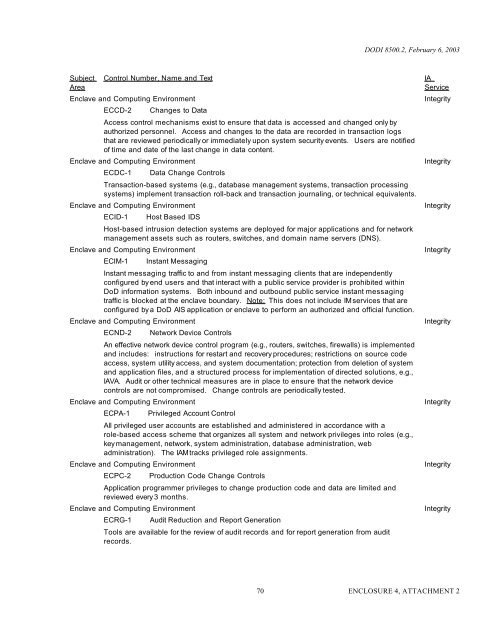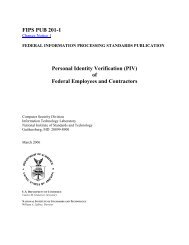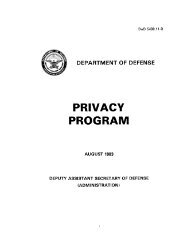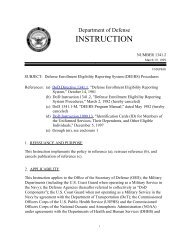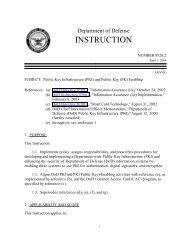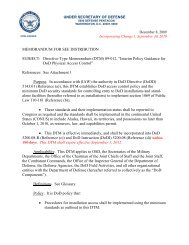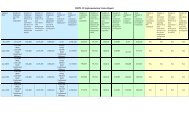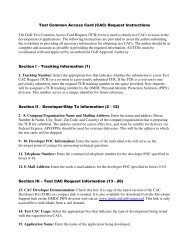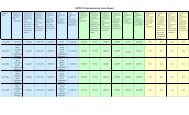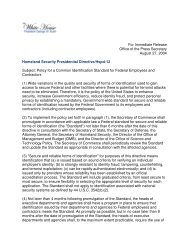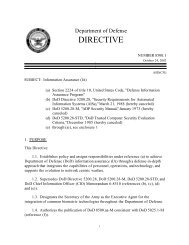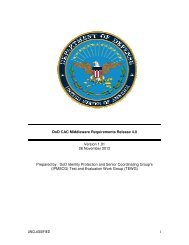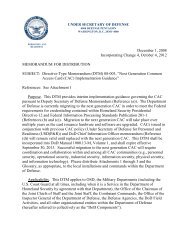DoD Instruction 8500.2 - Common Access Card (CAC)
DoD Instruction 8500.2 - Common Access Card (CAC)
DoD Instruction 8500.2 - Common Access Card (CAC)
Create successful ePaper yourself
Turn your PDF publications into a flip-book with our unique Google optimized e-Paper software.
DODI <strong>8500.2</strong>, February 6, 2003<br />
Subject<br />
Area<br />
Control Number, Name and Text<br />
Enclave and Computing Environment<br />
ECCD-2<br />
Changes to Data<br />
<strong>Access</strong> control mechanisms exist to ensure that data is accessed and changed only by<br />
authorized personnel. <strong>Access</strong> and changes to the data are recorded in transaction logs<br />
that are reviewed periodically or immediately upon system security events. Users are notified<br />
of time and date of the last change in data content.<br />
Enclave and Computing Environment<br />
ECDC-1<br />
Data Change Controls<br />
Transaction-based systems (e.g., database management systems, transaction processing<br />
systems) implement transaction roll-back and transaction journaling, or technical equivalents.<br />
Enclave and Computing Environment<br />
ECID-1<br />
Host Based IDS<br />
Host-based intrusion detection systems are deployed for major applications and for network<br />
management assets such as routers, switches, and domain name servers (DNS).<br />
Enclave and Computing Environment<br />
ECIM-1<br />
Instant Messaging<br />
Instant messaging traffic to and from instant messaging clients that are independently<br />
configured by end users and that interact with a public service provider is prohibited within<br />
<strong>DoD</strong> information systems. Both inbound and outbound public service instant messaging<br />
traffic is blocked at the enclave boundary. Note: This does not include IM services that are<br />
configured by a <strong>DoD</strong> AIS application or enclave to perform an authorized and official function.<br />
Enclave and Computing Environment<br />
ECND-2<br />
Network Device Controls<br />
An effective network device control program (e.g., routers, switches, firewalls) is implemented<br />
and includes: instructions for restart and recovery procedures; restrictions on source code<br />
access, system utility access, and system documentation; protection from deletion of system<br />
and application files, and a structured process for implementation of directed solutions, e.g.,<br />
IAVA. Audit or other technical measures are in place to ensure that the network device<br />
controls are not compromised. Change controls are periodically tested.<br />
Enclave and Computing Environment<br />
ECPA-1<br />
Privileged Account Control<br />
All privileged user accounts are established and administered in accordance with a<br />
role-based access scheme that organizes all system and network privileges into roles (e.g.,<br />
key management, network, system administration, database administration, web<br />
administration). The IAM tracks privileged role assignments.<br />
Enclave and Computing Environment<br />
ECPC-2<br />
Production Code Change Controls<br />
Application programmer privileges to change production code and data are limited and<br />
reviewed every 3 months.<br />
Enclave and Computing Environment<br />
ECRG-1<br />
Audit Reduction and Report Generation<br />
Tools are available for the review of audit records and for report generation from audit<br />
records.<br />
IA<br />
Service<br />
Integrity<br />
Integrity<br />
Integrity<br />
Integrity<br />
Integrity<br />
Integrity<br />
Integrity<br />
Integrity<br />
70 ENCLOSURE 4, ATTACHMENT 2


